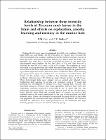| dc.contributor.author | HOLLAND, CELIA | en |
| dc.date.accessioned | 2010-06-18T15:58:39Z | |
| dc.date.available | 2010-06-18T15:58:39Z | |
| dc.date.issued | 2001 | en |
| dc.date.submitted | 2001 | en |
| dc.identifier.citation | Cox, D. and Holland, C., The relationship between three intensity levels of Toxocara canis larvae in the brain and effects on exploration, anxiety, learning and memory in the murine host, Journal of Helminthology, 75, 2001, 33 - 41 | en |
| dc.identifier.other | Y | en |
| dc.identifier.uri | http://hdl.handle.net/2262/40192 | |
| dc.description | PUBLISHED | en |
| dc.description.abstract | Outbred LACA mice were administered low (100 ova), medium (1000 ova), high (3000 ova) and trickle (4?250 ova) doses of Toxocara canis ova and the effect of infection was examined with respect to the number of larvae recovered from the brain and their behaviour. Recovery of larvae from the brain was generally low with the % recovery expressed in terms of the total dose administered being highest for the 3000 dose (6.1%) and 1000 dose (6%), followed by the 100 (4.4%) and trickle (3.5%) doses. The variation in larval recoveries was large between individual mice receiving similar doses. The level of infection in the brain was lower in mice receiving a multiple as opposed to an equivalent single dose of ova. Mice were then divided into three larval intensity groupings based upon the number of larvae recovered from their brain. The ranges for the groups were as follows: low intensity group, 0?15 larvae; moderate intensity group, 27?55 larvae; high intensity group, 66?557 larvae. Three behavioural tests were carried out on control and infected mice. Exploration and response to novelty was examined using a `T? maze and learning was investigated by means of a water-finding task. Anxiety was measured using an elevated plus maze apparatus. Infected mice were less explorative and less responsive to novelty in the `T? maze and this was particularly pronounced for the heavily infected mice. In the elevated plus maze, infected mice displayed reduced levels of anxiety to aversive and exposed areas of the maze, particularly in the case of the moderate and high intensity mice. There was evidence for impaired learning ability in the water task apparatus for moderate and high intensity mice. In general, the effects of infection on behaviour were more pronounced in the moderate and high intensity groups compared to the low intensity group. | en |
| dc.format.extent | 33 | en |
| dc.format.extent | 41 | en |
| dc.language.iso | en | en |
| dc.relation.ispartofseries | Journal of Helminthology | en |
| dc.relation.ispartofseries | 75 | en |
| dc.rights | Y | en |
| dc.subject | Parasitology | en |
| dc.subject | Toxocara canis | en |
| dc.title | The relationship between three intensity levels of Toxocara canis larvae in the brain and effects on exploration, anxiety, learning and memory in the murine host | en |
| dc.type | Journal Article | en |
| dc.type.supercollection | scholarly_publications | en |
| dc.type.supercollection | refereed_publications | en |
| dc.identifier.peoplefinderurl | http://people.tcd.ie/cholland | en |
| dc.identifier.rssinternalid | 28736 | en |
| dc.identifier.rssuri | http://dx.doi.org/10.1079/JOH200028 | en |




